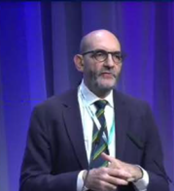Single-dose RSVPreF3 OA vaccine effective over 3 RSV seasons in seniors





A single dose of adjuvanted respiratory syncytial virus (RSV) prefusion F protein–based vaccine (RSVPreF3 OA) is efficacious against RSV-related lower respiratory tract disease (RSV-LRTD) over three RSV seasons in older adults aged ≥60 years, according to results of the phase III AReSVi-006 trial presented at ESCMID Global 2025.
Protection over 3 RSV seasons
“This is the first trial to show efficacy of one of the licensed RSV vaccines over three RSV seasons,” highlighted study author, Professor Alberto Papi, Director of the Respiratory Unit at the University of Ferrara, Italy.
 Prof Alberto Papi
Prof Alberto Papi
After a median follow-up of 30.6 months, the confirmatory secondary objective (efficacy against RSV-LRTD over three RSV seasons) was met. A single dose of RSVPreF3 OA was efficacious in preventing RSV-LRTD over three RSV seasons in adults aged ≥60 years (cumulative efficacy, 62.9 percent; 97.5 percent confidence interval [CI], 46.7–74.8). [ESCMID Global 2025, abstract JS2; Lancet Respir Med 2025;doi:10.1016/S2213-2600(25)00048-7]
Notably, efficacy of single-dose RSVPreF3 OA was demonstrated for both RSV A (69.8 percent; 95 percent CI, 42.2–85.7) and RSV B (58.6 percent; 95 percent CI, 35.9–74.1) over three seasons.
“The predominant circulating RSV subtype varies from year to year and across regions in the world, highlighting the importance of an RSV vaccine that helps protect against both subtypes,” commented Papi.
The study population included a considerable proportion of high-risk patients. Approximately 38 percent of patients were pre-frail or frail, and 40 percent had ≥1 comorbidity of interest, including chronic obstructive pulmonary disease, asthma, any chronic respiratory or pulmonary disease, chronic heart failure, diabetes mellitus, and advanced liver or renal diseases.
Vaccine effectiveness against RSV-LRTD was maintained over three seasons, regardless of age (60–69 years, 60.3 percent; 70–79 years, 70.6 percent), frailty status (pre-frail, 70.1 percent), baseline comorbidity (≥1 comorbidity of interest, 64.7 percent). “Efficacy in participants who were frail and those aged 80 years or older could not be reliably estimated because of the low number of cases in these subgroups,” he added.
RSVPreF3 OA was also effective across the spectrum of RSV-LRTD, including RSV-related acute respiratory illness, severe RSV-LRTD, and cases requiring medical attention.
Favourable benefit-risk profile
RSVPreF3 OA showed an acceptable safety profile. The frequency of intervention-related serious adverse events remained low and comparable between groups (both 0.1 percent). Five deaths were assessed to be related to the trial’s intervention (vaccine group, n=3; placebo group, n=2), but all cases had pre-existing or concurrent medical conditions or occurred long after vaccination (30, 656 and 842 days).
“These results support the favourable benefit-risk profile of RSVPreF3 OA to help protect against RSV-LRTD over three RSV seasons,” he commented.
The respiratory specialist’s view
“Prevention is key, as treatment options for severe RSV-LRTD [ie, pneumonia] in hospitalized patients are limited to supportive care. Additionally, RSV is one of the most relevant triggers of exacerbations of chronic airway diseases and is pivotal in the progression of these respiratory conditions,” said Papi. “Vaccination must be an essential part of our management strategy, as it is the only way we can help our patients prevent what is preventable.”